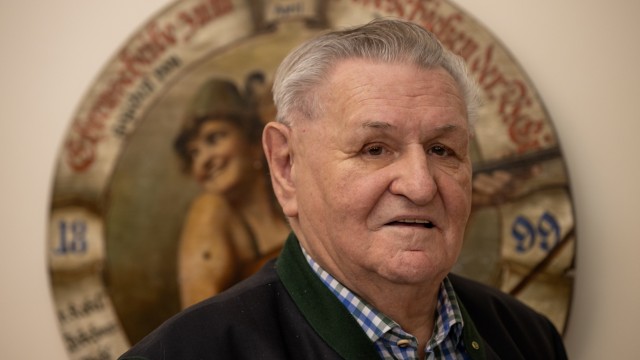Given this abundance, where should we look first? The display cases in the hall with all the trophies and memorabilia, the paintings of deceased members of the high and wealthy nobility, the long row of shooting ranges, the collection of fine shooting targets from several centuries? One floor higher, in the Prince’s Room, where the board meets and portraits of all of Munich’s former mayors adorn the walls, the history continues. And right next door, in the ballroom with its barrel vault, the original Schützenliesl, painted by Friedrich August von Kaulbach, beckons in a giant format of 5.20 x 2.80 meters. His model, the Oktoberfest waitress Coletta Möritz, has had a blast in life, and not just three times, as an eternal Oktoberfest hit misleadingly says.
Welcome to the Royal Privileged Main Rifle Society (HSG) in Obersendling, “the oldest and most successful rifle society in the city.” Visiting today is the Munich-South History Workshop. This working group has been unerringly exploring historical “highlights” for some time now. She has already explored Fürstenried Castle, the old Solln church and the network of a weathered railway track system.
So now the traditional HSG, which was first mentioned in the city’s annals in 1406. At a time when the Teutonic Knights marched into Poland to get a bloody nose in the Battle of Tannenberg. Founded near Munich’s main train station, on Schützenstrasse, the company was initially responsible for protecting the city. When, after a stopover at Theresienwiese, she purchased a free, nine-hectare field on Zielstattstrasse in Obersendling for 600,000 guilders in 1893, no one could have imagined what a treasure trove of shooting sports would one day emerge here. And also one of the most beautiful large beer gardens in Munich.
Leadership at the HSG shooting club. The Munich History Workshop visits the premises.
(Photo: Catherina Hess)
If you’re lucky, like the history workshop, you’ll win honorary master marksman Kurt Mayor for a tour of the stately-looking, listed HSG property. The man is a walking collection of anecdotes. Someone who knows why Augustiner is the gastropub tenant here (“other breweries took a little too long to sign”) and which Olympic and world champions come from his shooting company (Gottfried Kustermann, Gary Anderson). He also tells his astonished audience that in times gone by, master riflemen enjoyed the privilege of tax exemption and the right to “keep a pig.”
When the mayor introduces himself with his name to the city’s leaders, he is said to cause a mild disturbance and receive a slightly indignant answer: “Well, I’m already mayor.” He also remembers losses that are hard to believe considering the countless trophies and medals in the so-called Ladsaal with a malicious smile: “Mei, after the war the Americans took a lot with them.”
Kurt Mayor, the girl in charge at the main shooting club, also knows about the changing times. For a long time, the HSG was taboo for female members. And today? “Of course we also have female marksmen.” What has also changed: Targeting targets with human depictions is no longer as commonplace as it once was.
The mayor proudly presents the modern electronic shooting ranges, one of which he set up himself. The associated requirements of the district administration department still shock him like the detonation of a cartridge box: hundreds of thousands of euros had to be invested in steel-reinforced ceilings and beams, ventilation systems and gun cabinets with safes. Duke Albrecht of Bavaria, who once shot his hunting rifles here, would certainly never have dreamed of something like this. Just like previous efforts by the government of Upper Bavaria to dissolve the shooting society because it does not appear in any association register and therefore has no liable board of directors.
Women are now also allowed to shoot
The HSG today primarily has more than 700 members, and the trend is rising. Some of their pistol shooters take part in Bundesliga competitions. Shooting takes place seven days a week, and there is even professional training for young people. There is plenty of space on the spacious grounds at the end of Zielstattstrasse: for a biathlon course, an old coach house that is currently being renovated, its own soccer field, an in-house workshop, and the renowned “Augustiner Schützengarten” inn. Another specialty are 100-meter-long shooting ranges, which only occur in Bavaria. You can shoot with almost anything that has a trigger, from a crossbow to a fire nozzle. These things shoot up to 450 meters. However, small-caliber rifles and air rifles and distances of up to 50 meters are more common.

Honorary Marksman Kurt Mayor leads the guests through the HSG property.
(Photo: Catherina Hess)
Not everyone can become a member of the Royals. “We want athletes, not shooters,” says Kurt Mayor. Once accepted and ceremoniously welcomed in the Prince’s Room, it is worth sticking with it for the long term. After 50 years of membership, the association donates a painted portrait and a badge of honor with a diamond. Aiming for the office of Munich mayor also pays off. Because whoever makes it, the royally privileged riflemen invite them to become their “chief rifle commissioner”. Such honors were previously bestowed on crowned heads, such as Bavaria’s last king, Ludwig III.
Otherwise, anyone who helps to preserve the valuable architectural heritage will hit the mark at the Schützengesellschaft. Because this cannot be achieved with annual contributions of 130 euros alone. The last round of renovations cost five million euros. Kurt Mayor remembers with a shudder: “Other problems kept cropping up, starting with the skirting boards in the halls.”
Based on this, noise complaints from the neighborhood are rather easy to counteract. After all, the shooting society first spread locally, long before the residential buildings in the area. Undoubtedly true; In 1893 this corner of Sendling was still a wide meadow.

